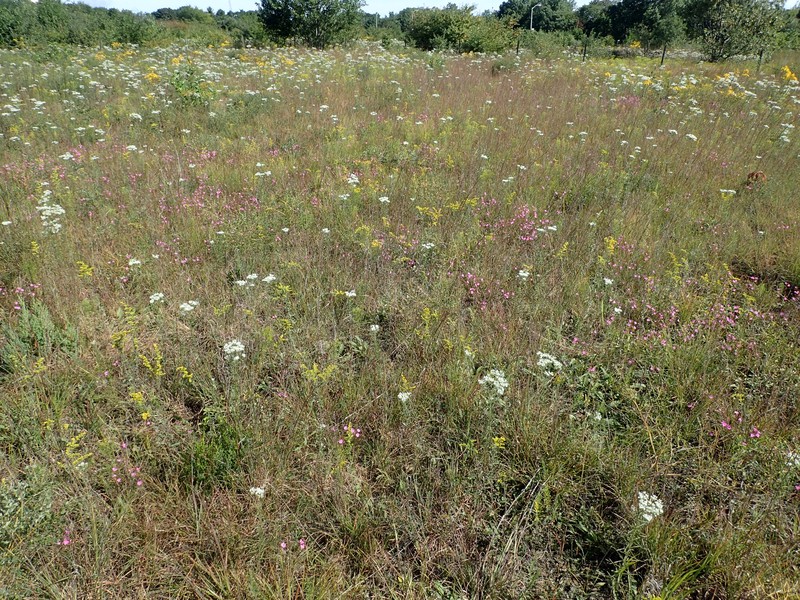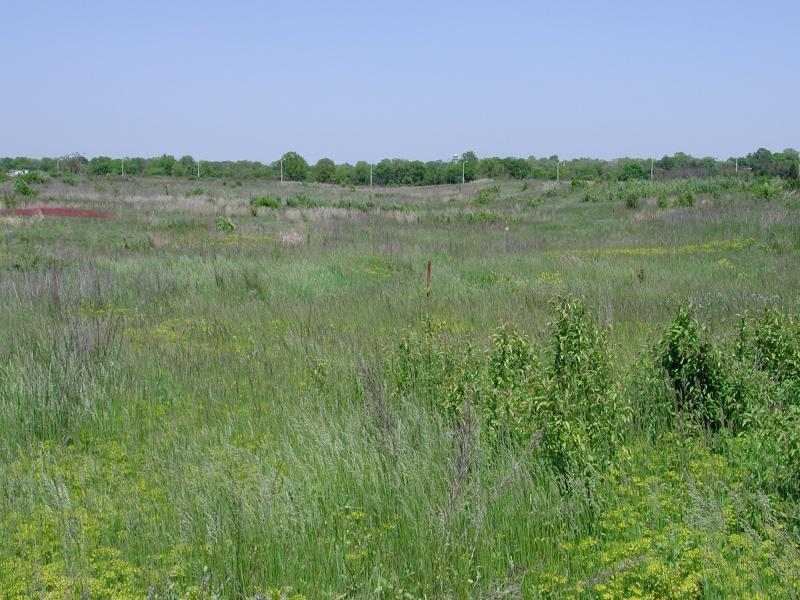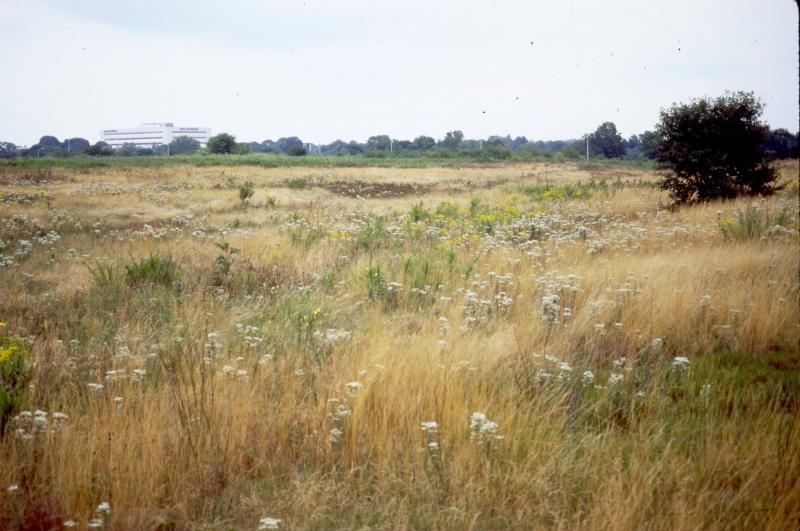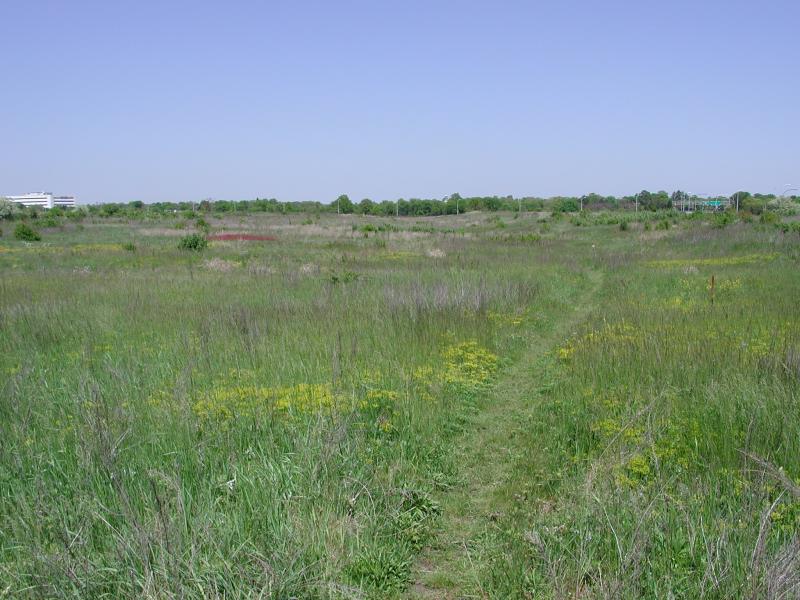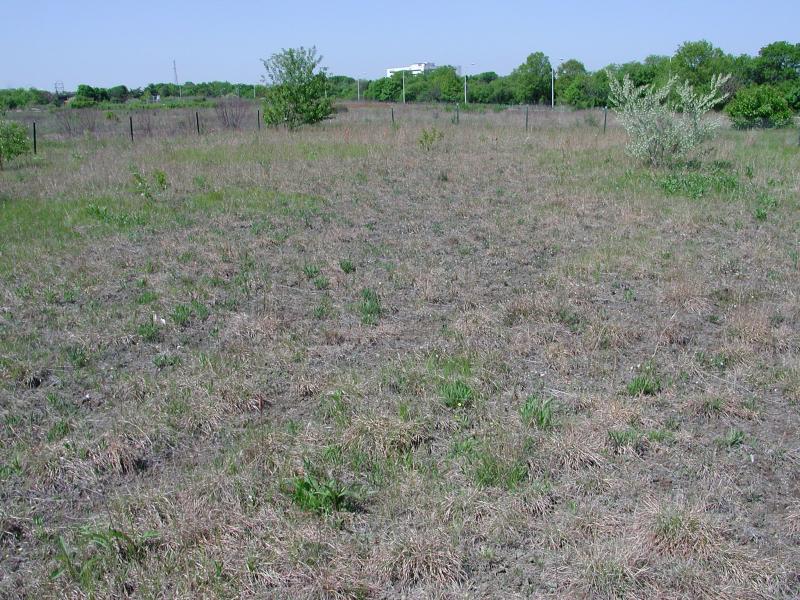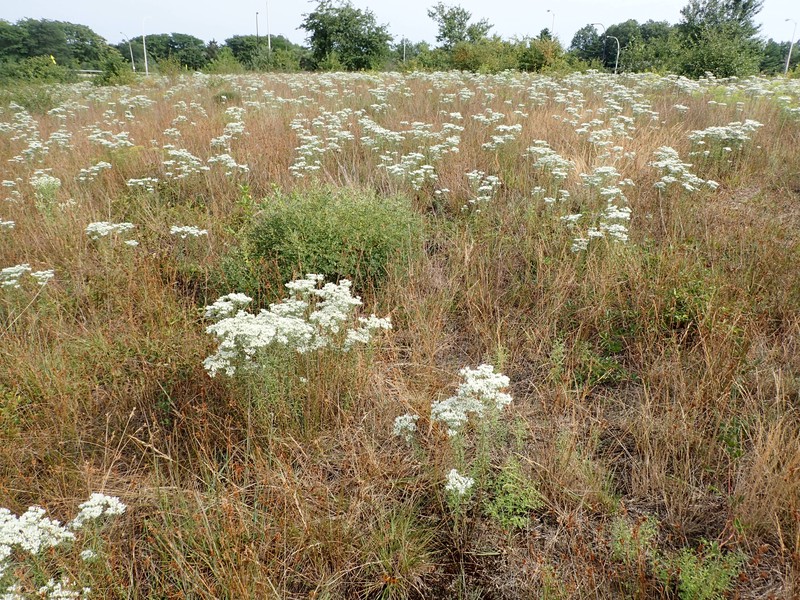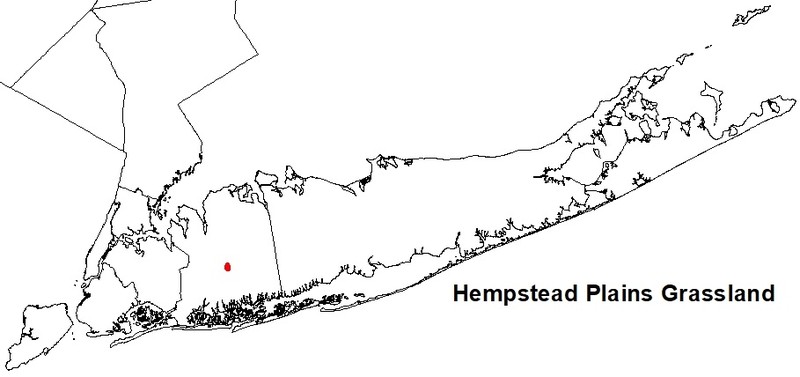Hempstead Plains Grassland
- System
- Terrestrial
- Subsystem
- Open Uplands
- State Protection
- Not Listed
Not listed or protected by New York State.
- Federal Protection
- Not Listed
- State Conservation Status Rank
- S1
Critically Imperiled in New York - Especially vulnerable to disappearing from New York due to extreme rarity or other factors; typically 5 or fewer populations or locations in New York, very few individuals, very restricted range, very few remaining acres (or miles of stream), and/or very steep declines.
- Global Conservation Status Rank
- G1Q
Critically Imperiled globally - At very high risk of extinction due to extreme rarity or other factors; typically 5 or fewer populations or locations in the world, very few individuals, very restricted range, very few remaining acres (or miles of stream), and/or very steep declines. The Q indicates this species' status as a distinct full species, or this community's status as a distinct community type, is uncertain.
Summary
Did you know?
For over fifty years, the once expansive Hempstead Plains (named after the Village of Hempstead, which was founded in 1644) served as a Cradle of Aviation in Nassau County. By 1910, The Plains, which covered over 50 square miles, were home to three airfields and a few flying schools. One of these airfields, Roosevelt Field (previously known as the Hempstead Plains Aerodrome), was the departure point for Charles Lindbergh's historic 1927 transatlantic flight to Paris.
State Ranking Justification
While once a part of an extensive grassland system, Hempstead Plains grassland is now restricted to one site on the coastal lowlands in Nassau County in western Long Island. This one documented occurrence represents the only known location for this globally rare community; no additional sites are expected to be discovered. The remnant occurrence has fair to poor viability and is protected on public or private land. It is vulnerable to development, which is the most crucial impending threat to the community. The community's trend, overall, is declining due to invasive species encroachment, woody species invasion, and trash dumping.
Short-term Trends
In recent decades, the acreage of this community has remained somewhat stable but may be declining as shrubs invade the edges. The community's quality/viability has declined due to invasive species encroachment, fire suppression, and trash dumping.
Long-term Trends
The acreage and number of Hempstead Plains grasslands has severely declined from their historical extent due to development. Greater than 99% of the community's area of occupancy has been lost.
Conservation and Management
Threats
The existing remnant patches of Hempstead Plains grassland are surrounded by urban development and illegal garbage dumping has been common. The community is extremely vulnerable to further development and associated disturbances. It has been colonized by invasive exotic species, including Lespedeza cuneata, Artemesia vulgaris, and Euphorbia cyparissias, which have the potential to spread further throughout the community. Fire suppression threatens to convert the community from open grasslands to successional shrublands or successional southern hardwoods.
The following nine invasive plants were identified as management priorities in 2018 in the parcel with the best remaining Hempstead Plains grassland (n=25 points sampled): 1. Agrostis capillaris was found at 10 points (40%) with an average cover of 27%. 2. Artemisia vulgaris was found at five points (20%) with an average cover of 30%. 3. Celastrus orbiculatus was found at five points (20%) with an average cover of 22%. 4. Cynanchum loiseae was found at one point (A18) with 5% cover. 5. Elaeagnus umbellata was found at four points (16%) with an average cover of 14%. 6. Festuca trachyphylla was found at five points (20%) with an average cover of 17%. 7. Lespedeza cuneata was found at ten points (40%) with an average cover of 17%. 8. Lonicera japonica was found at five points (20%) with an average cover of 32%. 9. Malus toringo was found at eight points (32%) with an average cover of 11% (Edinger and Young 2018).
Conservation Strategies and Management Practices
Restore and replicate the natural fire regime, as appropriate. Implement restoration including trash clearing, reducing woody species as they invade, and removing invasive exotic species and monitoring their abundance. Monitor visitor use and work with landowner to restrict access if excess trampling and cycling is negatively affecting the community. Investigate the feasibility of restoring nearby natural areas back to this community type.
Development and Mitigation Considerations
This community is located in a landscape that is heavily developed. Connections to adjacent communities are unlikely to exist. However, adequate protection, restoration, proper management, and no further development in and around the site, should allow the grassland's viability to improve.
Inventory Needs
Aerial surveys for this community have been conducted and no other remnants were found. More compositional data, including plot data collection, is needed, as is additional data on rare and characteristic animals.
Research Needs
Documentation of the natural fire regime of this community is needed.
Rare Species
- Agalinis decemloba (Sandplain Agalinis) (guide)
- Aletris farinosa (White Colicroot) (guide)
- Ammodramus henslowii (Henslow's Sparrow) (guide)
- Asclepias purpurascens (Purple Milkweed) (guide)
- Asclepias viridiflora (Green Milkweed) (guide)
- Bartramia longicauda (Upland Sandpiper) (guide)
- Callophrys irus (Frosted Elfin) (guide)
- Carex mesochorea (Midland Sedge) (guide)
- Circus hudsonius (Northern Harrier) (guide)
- Crocanthemum dumosum (Bushy Rock Rose) (guide)
- Datana ranaeceps (A Hand-maid Moth) (guide)
- Desmodium ciliare (Hairy Small-leaved Tick Trefoil) (guide)
- Gentiana saponaria (Soapwort Gentian) (guide)
- Polygala nuttallii (Nuttall's Milkwort) (guide)
- Pycnanthemum muticum (Blunt Mountain Mint) (guide)
- Sericocarpus linifolius (Narrow-leaved White-topped Aster) (guide)
- Symphyotrichum concolor var. concolor (Eastern Silvery Aster) (guide)
- Tripsacum dactyloides (Northern Gama Grass) (guide)
- Viola brittoniana (Britton's Coast Violet) (guide)
Range
New York State Distribution
Hempstead Plains grassland is restricted to the coastal lowlands in Nassau County in western Long Island. Historically, it covered a fairly large area of western Long Island (roughly 38,000 acres), which may have been in the central part of its historical range from Massachusetts to New Jersey.
Global Distribution
Hempstead Plains grassland is restricted to the coastal lowlands in Nassau County in western Long Island, New York. Historically, it may have ranged from Massachusetts to New Jersey. The community is related to midwestern grasslands, and it may represent the easternmost occurrence of a community known as a "sand prairie" in the midwestern United States (NatureServe 2009).
Best Places to See
- Mitchel Field, Nassau Community College (Nassau County)
Identification Comments
General Description
A tall grassland community that occurs on rolling outwash plains in west-central Long Island. This community occurs inland, beyond the influence of offshore winds and salt spray. Historically this community covered about 15,000 hectares (approximately 38,000 acres) of western Long Island; less than around 15 hectares (37 acres) remain today, and most of these are severely degraded.
Characters Most Useful for Identification
This community was dominated by species characteristic of midwestern tallgrass prairie: big bluestem (Andropogon gerardii), little bluestem (Schizachyrium scoparium), Indian grass (Sorghastrum nutans), and switchgrass (Panicum virgatum). These species are present in today's remnants, but they are not always dominant. Other characteristic species that still occur in this community include rush (Juncus greenei), wild indigo (Baptisia tinctoria), Canada cinquefoil (Potentilla canadensis), gray goldenrod (Solidago nemoralis), early goldenrod (Solidago juncea), butterfly-weed (Asclepias tuberosa), stargrass (Hypoxis hirsuta), fringed violet (Viola sagittata), bird's-foot violet (V. pedata), stiff-leaf aster (Ionactis linariifolius), hyssop-leaved boneset (Eupatorium hyssopifolium), and northern dewberry (Rubus flagellaris). Characteristic birds include vesper sparrow (Pooecetes gramineus), savannah sparrow (Passerculus sandwichensis), grasshopper sparrow (Ammodramus savannarum), and bobolink (Dolichonyx oryzivorus).
Best Time to See
This grassland can be beautiful throughout the growing season. In early spring, from April to June the yellow cinquefoils (Potentilla spp.) come into bloom. Visit from June through August to see yellow wild indigo (Baptisia tinctoria), purple bird's-foot violet (Viola pedata), and bright orange butterfly weed (Asclepias tuberosa). The fall brings a profusion of goldenrods, asters, and dramatic flowering grasses.
Hempstead Plains Grassland Images
Classification
International Vegetation Classification Associations
This New York natural community encompasses all or part of the concept of the following International Vegetation Classification (IVC) natural community associations. These are often described at finer resolution than New York's natural communities. The IVC is developed and maintained by NatureServe.
- Little Bluestem - Indiangrass - Common Goldstar - Horseflyweed Grassland (CEGL006187)
NatureServe Ecological Systems
This New York natural community falls into the following ecological system(s). Ecological systems are often described at a coarser resolution than New York's natural communities and tend to represent clusters of associations found in similar environments. The ecological systems project is developed and maintained by NatureServe.
- Northern Atlantic Coastal Plain Heathland and Grassland (CES203.895)
Characteristic Species
-
Shrubs < 2m
- Rhus copallinum var. copallinum (common winged sumac)
-
Tree saplings
- Juniperus virginiana var. virginiana (eastern red cedar)
- Prunus serotina var. serotina (wild black cherry)
-
Herbs
- Agalinis decemloba (sandplain agalinis)
- Andropogon gerardi (big bluestem)
- Andropogon virginicus var. virginicus (broom-sedge bluestem)
- Asclepias tuberosa (butterfly-weed)
- Baptisia tinctoria (wild-indigo)
- Bulbostylis capillaris (tufted hair sedge)
- Crocanthemum canadense (Canada frostweed, Canada rock-rose)
- Crocanthemum propinquum (low frostweed, low rock-rose)
- Cyperus lupulinus ssp. macilentus (eastern flat sedge)
- Desmodium ciliare (hairy small-leaved tick-trefoil)
- Dichanthelium lindheimeri (Lindheimer's rosette grass)
- Eupatorium hyssopifolium (hyssop-leaved thoroughwort)
- Euthamia caroliniana (slender flat-topped-goldenrod)
- Hypericum gentianoides (orange-grass)
- Ionactis linariifolia (stiff-leaved-aster)
- Juncus greenei (Greene's rush)
- Lechea maritima var. maritima (beach pinweed)
- Lespedeza capitata (round-headed bush-clover)
- Lespedeza virginica (slender bush-clover)
- Nuttallanthus canadensis (old-field-toad-flax)
- Panicum virgatum (switch grass)
- Polygala nuttallii (Nuttall's milkwort)
- Schizachyrium scoparium var. scoparium (little bluestem)
- Scleria pauciflora (few-flowered nut sedge)
- Solidago juncea (early goldenrod)
- Solidago nemoralis ssp. nemoralis (gray goldenrod)
- Sorghastrum nutans (Indian grass)
- Trichostema dichotomum (blue-curls)
- Viola pedata var. pedata (bird's-foot violet)
Similar Ecological Communities
- Maritime grassland
(guide)
Maritime grassland occurs near the ocean within the range of offshore winds and salt spray and is dominated by little bluestem, common hairgrass, and poverty-grass. Hempstead Plains grassland occurs further inland and is dominated by species characteristic of midwestern tallgrass prairies: big bluestem (Andropogon gerardii), little bluestem, Indian grass, and switchgrass (Panicum virgatum).
- Successional northern sandplain grassland
(guide)
While these communities may share similar species, successional northern sandplain grasslands occur on sandy soil and are dominated by bluestem (Schizachyrium scoparium), hairgrass (Avenella flexuosa), Pennsylvania sedge (Carex pensylvanica), poverty grass (Danthonia spicata), and panic grasses (Dichanthelium spp.) Hempstead Plains grasslands are a tall grassland community that occurs on rolling outwash plains in west-central Long Island and are dominated by little bluestem (Schizachyrium scoparium), rush (Juncus greenei), and hyssop-leaved boneset (Eupatorium hyssopifolium).
- Successional old field
Successional old fields are dominated by characteristically successional species of grasses and forbs, including goldenrods, bluegrasses, timothy, orchard grass, and chickweeds. Typical tallgrass prairie species that characterize Hempstead Plains grasslands (big bluestem, little bluestem, Indian grass, and switchgrass) are either absent or present in low abundance.
Vegetation
Percent cover
This figure helps visualize the structure and "look" or "feel" of a typical Hempstead Plains Grassland. Each bar represents the amount of "coverage" for all the species growing at that height. Because layers overlap (shrubs may grow under trees, for example), the shaded regions can add up to more than 100%.
Additional Resources
References
Blizzard, Alpheus W. 1931. Plant sociology and vegetational change on High Hill, Long Island, New York. Ecology 12(1):208-231.
Cain, S. A., M. Nelson, and W. McLean. 1937. Andropogonetum Hempsteadi: A Long Island grassland vegetation type. The American Midland Naturalist 18(3):334-350.
Edinger, G. J., D. J. Evans, S. Gebauer, T. G. Howard, D. M. Hunt, and A. M. Olivero (editors). 2014. Ecological Communities of New York State. Second Edition. A revised and expanded edition of Carol Reschke’s Ecological Communities of New York State. New York Natural Heritage Program, New York State Department of Environmental Conservation, Albany, NY. https://www.nynhp.org/ecological-communities/
Ferguson, William C. 1925. Ferns and flowering plants of the Hempstead Plains, Long Island, New York. Torreya 25(6):109-113.
Grossman, D. H., K. Lemon Goodin, and C. L. Reuss, editors. 1994. Rare plant communities of the conterminous United States: An initial survey. The Nature Conservancy. Arlington, VA. 620 pp.
Harper, R.M. 1911. The Hempstead Plains. A natural prairie on Long Island. Bulletin American Geographic Society 43:351-360.
Harper, R.M. 1912. The Hempstead Plains of Long Island. Torreya 12(12):277-287.
Harper, R.M. 1918. The vegetation of the Hempstead Plains. Mem. Torrey Botanical Club 17: 262-286.
Hicks, Henry. 1892. The flora of the Hempstead Plains, Long Island. Unpublished manuscript (thesis), Cornell University.
Kirby, J. 1905. Some plants of Hempstead Plains. The American Botanist 7:110-111.
McManus, Arthur T. No date. The Hempstead Plains - a vanishing heritage? Prepared for the citizens for Hempstead Plains.
NatureServe. 2015. NatureServe Explorer: An online encyclopedia of life [web application]. Version 7.1. NatureServe, Arlington, Virginia. Available http://www.natureserve.org/explorer.
Neidich, Carole. 1980. The Hempstead Plains and the birdfoot violet. Long Island Forum XLIII(6):108-115.
Neidich-Ryder, C. and P. Kennelly. 2013. Mapping prairie remnants on the Hempstead Plains, Long Island, New York. Environ Monit Assess. Springer Science. Published online: 11 January 2014.
New York Natural Heritage Program. 2024. New York Natural Heritage Program Databases. Albany, NY.
Reschke, Carol. 1990. Ecological communities of New York State. New York Natural Heritage Program, New York State Department of Environmental Conservation. Latham, NY. 96 pp. plus xi.
Seyfert, W. G. 1973. A study of the Hempstead Plains, Long Island, New York, and its vascular flora. M.S. thesis, C. W. Post College, Long Island University, Greenvale, NY.
Seyfert, Wayne G. No date. The Hempstead Plains America's first prairie. Nassau County History Society Journal. pp 3-16.
Stalter, R. 1981. Some ecological observations of Hempstead Plains, Long Island, New York. Proc. of the Northeastern Weed Science Society 35:101-106.
Stalter, R. and E.E. Lamont. 1987. Vegetation of Hempstead Plains, Mitchell Field, Long Island, New York. Bull. Torr. Bot. Club 114: 330-335.
Stalter, R. and W. G. Seyfert. 1989. "The Vegetation History of Hempstead Plains, New York" (1989). Proceedings of the North American Prairie Conferences. 56. http://digitalcommons.unl.edu/napcproceedings/56
Watson, Winslow C. 1860. The plains of Long Island. C. Van Benthuysen.
da Silva Quintal, Sara N. 2011. Invasive Species Management Plan for Hempstead Plains at Nassau Community College, Garden City, New York. Nelson, Pope & Voorhis, LLC., Melville, NY.
Links
About This Guide
This guide was authored by: Aissa Feldmann
Information for this guide was last updated on: December 12, 2023
Please cite this page as:
New York Natural Heritage Program. 2024.
Online Conservation Guide for
Hempstead Plains grassland.
Available from: https://guides.nynhp.org/hempstead-plains-grassland/.
Accessed July 26, 2024.
